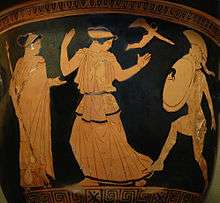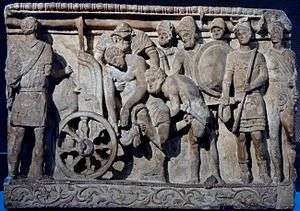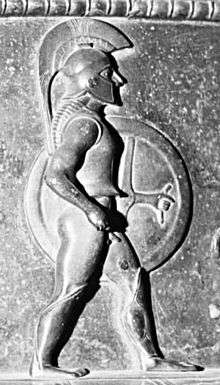Menelaus
| Menelaus | |
|---|---|
| King of Sparta | |
_-_n._4140_-_Roma_-_Vaticano_-_Menelao_-_Busto_in_marmo.jpg) Marble bust of Menelaus | |
| Predecessor | Tyndareus |
| Wife | Helen of Troy |
|
Issue | |
| Father | Atreus |
| Mother | Aerope |
In Greek mythology, Menelaus (/ˌmɛnɪˈleɪəs/; Greek: Μενέλαος, Menelaos, from < μένος· vigor, rage, power + λαός· people, "wrath of the people") was a king of Mycenaean (pre-Dorian) Sparta, the husband of Helen of Troy, and a central figure in the Trojan War. He was the son of Atreus and Aerope, brother of Agamemnon, king of Mycenae and, according to the Iliad, leader of the Spartan contingent of the Greek army during the War. Prominent in both the Iliad and Odyssey, Menelaus was also popular in Greek vase painting and Greek tragedy, the latter more as a hero of the Trojan War than as a member of the doomed House of Atreus.
Ascension and reign
Although early authors such as Aeschylus refer in passing to Menelaus’ early life, detailed sources are quite late, post-dating 5th-century BC Greek tragedy.[1] According to these sources, Menelaus' father, Atreus, had been feuding with his brother Thyestes over the throne of Mycenae. After a back-and-forth struggle that featured adultery, incest and cannibalism, Thyestes gained the throne after his son Aegisthus murdered Atreus. As a result, Atreus’ sons, Menelaus and Agamemnon, went into exile. They first stayed with King Polyphides of Sicyon, and later with King Oeneus of Calydon. But when they thought the time was ripe to dethrone Mycenae’s hostile ruler, they returned. Assisted by King Tyndareus of Sparta, they drove Thyestes away, and Agamemnon took the throne for himself.
When it was time for Tyndareus’ step-daughter Helen to marry, many kings and princes came to seek her hand. Among the contenders were Odysseus, Menestheus, Ajax the Great, Patroclus, and Idomeneus. Most offered opulent gifts. Tyndareus would accept none of the gifts, nor would he send any of the suitors away for fear of offending them and giving grounds for a quarrel. Odysseus promised to solve the problem in a satisfactory manner if Tyndareus would support him in his courting of Tyndareus’s niece Penelope, the daughter of Icarius. Tyndareus readily agreed, and Odysseus proposed that, before the decision was made, all the suitors should swear a most solemn oath to defend the chosen husband in any quarrel. Then it was decreed that straws were to be drawn for Helen’s hand. The suitor who won was Menelaus (Tyndareus, not to displease the powerful Agamemnon offered him another of his daughters, Clytaemnestra).[2] The rest of the suitors swore their oaths, and Helen and Menelaus were married, Menelaus becoming a ruler of Sparta with Helen after Tyndareus and Leda abdicated the thrones. Menelaus and Helen had a daughter Hermione as supported, for example, by Sappho,[3] whilst some variations of the myth suggest they had three sons as well: Aithiolas, Maraphius, and Pleisthenes.
Their palace (ἀνάκτορον) has been discovered (the excavations started in 1926 and continued until 1995) in Pellana, Laconia, to the north-west of modern (and classical) Sparta.[4] Other archaeologists consider that Pellana is too far away from other Mycenaean centres to have been the "capital of Menelaus".[5]
Trojan War
In a return for awarding her a golden apple inscribed "to the fairest," Aphrodite promised Paris the most beautiful woman in all the world.[6] After concluding a diplomatic mission to Sparta during the latter part of which Menelaus was absent to attend the funeral of his maternal grandfather Catreus in Crete, Paris ran off to Troy with Helen in tow despite his brother Hector forbidding her to depart with them. Invoking the oath of Tyndareus, Menelaus and Agamemnon raised a fleet of one thousand ships according to legend and went to Troy to secure Helen's return; the Trojans were recalcitrant, providing a casus belli for the Trojan War.
Homer's Iliad is the most expansive source for Menelaus’s exploits during the Trojan War. In Book 3, Menelaus challenges Paris to a duel for Helen’s return. Menelaus soundly beats Paris, but before he can kill him and claim victory, Aphrodite spirits Paris away inside the walls of Troy. In Book 4, while the Greeks and Trojans squabble over the duel’s winner, Athena inspires the Trojan Pandarus to shoot Menelaus with his bow and arrow. However, Athena never intended for Menelaus to die and she protects him from the arrow of Pandarus.[7] Menelaus is wounded in the abdomen, and the fighting resumes. Later, in Book 17, Homer gives Menelaus an extended aristeia as the hero retrieves the corpse of Patroclus from the battlefield.
According to Hyginus, Menelaus killed eight men in the war, and was one of the Greeks hidden inside the Trojan Horse. During the sack of Troy, Menelaus killed Deiphobus, who had married Helen after the death of Paris.
There are four versions of Menelaus’ and Helen’s reunion on the night of the sack of Troy:
- Angry at Helen, Menelaus looked for and found her. In a fit of rage, he decided to kill her for leaving him for Paris, but when he raised his sword, she started to weep at her former husband's feet, begging for her life. In a split second, Menelaus' wrath went away instantly. He took pity on her, and decided to take her back as wife.
- Menelaus resolved to kill Helen but her striking beauty prompted him to drop his sword and take her back to his ship “to punish her at Sparta”, as he claimed.[8]
- According to the Bibliotheca, Menelaus raised his sword in front of the temple in the central square of Troy to kill her but his wrath went away when he saw her tearing her clothes in sorrow (to reveal her breasts).
- A similar version by Stesichorus in “Ilion’s Conquest” narrated that Menelaus surrendered her indeed to his soldiers to stone her to death; however, when she ripped the front of her robes, the Achaean warriors were stunned by her beauty and the stones fell harmlessly from their hands.
After the war
Book 4 of the Odyssey provides an account of Menelaus’ return from Troy and his homelife in Sparta. When visited by Odysseus’ son Telemachus, Menelaus recounts his voyage home. As happened to many Greeks, Menelaus' homebound fleet was blown by storms to Crete and Egypt where they were unable to sail away because the wind was calm. They trapped Proteus, who then told them how to make the voyage home. After their homecoming, Menelaus and Helen’s marriage is strained; Menelaus continually revisits the human cost of the Trojan War, particularly in light of the fact that he and Helen have no male heir. Menelaus is fond of Megapenthes and Nicostratus, his sons by other women. According to Euripides’ Helen, after Menelaus dies, he is reunited with Helen on the Isle of the Blessed.[9]
Menelaus in vase painting
Menelaus appears in Greek vase painting in the 6th to 4th centuries BC, such as: Menelaus’s reception of Paris at Sparta; his retrieval of Patroclus’s corpse; and his reunion with Helen.[10]
Menelaus in Greek tragedy
Menelaus appears as a character in a number of 5th-century Greek tragedies: Sophocles’ Ajax, and Euripides’ Andromache, Helen, Orestes, Iphigenia at Aulis, and The Trojan Women.
Menelaus in other media
- Menelaus is portrayed by Niall MacGinnis in the 1956 film Helen of Troy.
- Patrick Magee portrayed Menelaus in the 1971 film of The Trojan Women.
- In the Coen Brothers' O Brother, Where Art Thou?, which is loosely based on Odyssey, Charles Durning plays Governor Menelaus.
- In James Callis's revisionist 2003 miniseries Helen of Troy, Menelaus is encouraged to fight the Trojan War by his brother Agamemnon instead of by Helen’s infidelity or the resulting slight to his honour.
- Menelaus also appears in the 2004 film Troy, portrayed by Brendan Gleeson. Like the 1956 film that influenced it, Menelaus is portrayed as a brutish king out for revenge. He duels Paris and wins, but Paris retreats to his brother Hector, who kills Menelaus to protect Paris.
- In the Tabletop role-playing game Vampire: The Masquerade, Menelaus is a fourth generation Brujah.[11]
See also
Notes
- ↑ The chief sources for Menelaus' life before the Trojan War are Hyginus' Fabulae and the Epitome of the Bibliotheca.
- ↑
- ↑ Sappho, fr. 16. See an analysis of the poem by Gumpert, Grafting Helen, 92
- ↑ Palace of Helen
- ↑ Mee & Spawforth (2001), page 229
- ↑ See the Judgment of Paris.
- ↑ Homer; Lattimore, Richmond; Martin, Richard (2011). The Iliad of Homer. Chicago: University of Chicago Press. pp. 116–117. ISBN 9780226470498.
- ↑ Andromache, 629-31.
- ↑ Line 1675.
- ↑ Woodford 1993.
- ↑ Vampire: The Masquerade - Chicago by Night, p. 62-64
External links
| Wikisource has the text of the 1911 Encyclopædia Britannica article Menelaus. |
-
 Media related to Menelaus at Wikimedia Commons
Media related to Menelaus at Wikimedia Commons
| Regnal titles | ||
|---|---|---|
| Preceded by Tyndareus (second reign) |
King of Sparta | Succeeded by Orestes |


